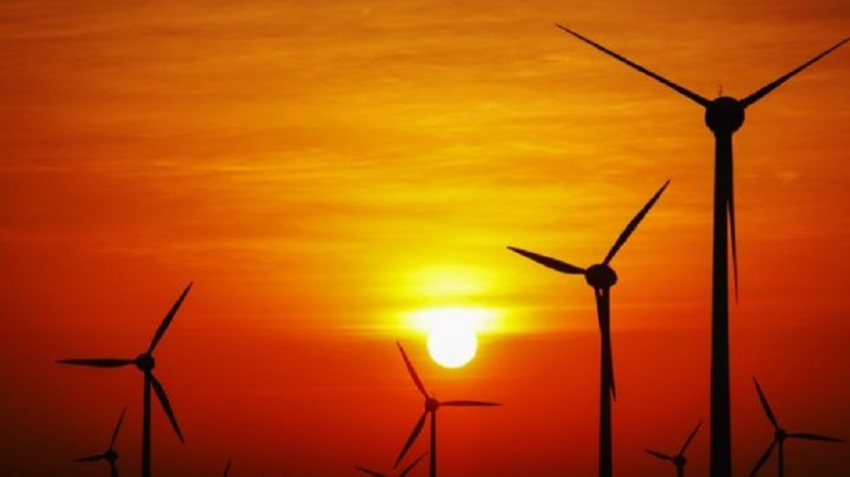By Matt McGrath
Carbon emissions have not yet peaked in many countries the report says
Global efforts to tackle climate change are way off track says the UN, as it details the first rise in CO2 emissions in four years.The emissions gap report says that economic growth is responsible for a rise in 2017 while national efforts to cut carbon have faltered.To meet the goals of the Paris climate pact, the study says it's crucial that global emissions peak by 2020.But the analysis says that this is now not likely even by 2030.
The report comes days before a major UN climate conference starting in Poland from 2-14 December.
UK summers could be over 5C warmer by 2070
Dire warning on US climate change impacts
Attenborough takes seat at climate talks
What is the emissions gap?For the last nine years, UN Environment have produced an assessment of the latest scientific studies on current and future emissions of greenhouse gases.
It highlights the difference between the level of greenhouse gas emissions that the world can sustain to keep temperatures within safe limits, with the levels that are likely based on the promises and actions taken by countries.
This year's report records the largest gap yet between where we are and where we need to be.
Why are emissions rising again?
Between 2014 and 2016, global emissions of CO2 from industry and the production of energy were essentially stable while the global economy grew modestly - but in 2017 these emissions went up by 1.2% pushed along by higher GDP.
Image copyrightGETTY IMAGES
Image caption
While renewable energy sources are booming in countries like India, carbon emissions haven't yet peaked
While the rise might seem small, it needs to be seen in context of efforts to keep global temperatures from rising by more than 1.5C, as recently outlined in a key IPCC report.
According to the UN, to keep the world below that target, global greenhouse gas emissions in 2030 would have to be 55% lower than today.
"There is still a tremendous gap between words and deeds, between the targets agreed by governments worldwide to stabilise our climate and the measures to achieve these goals," said Dr Gunnar Luderer, from the Potsdam Institute for Climate Impact Research and one of the authors of the study.
The scientists say that to tackle the gap, nations must raise their ambition five fold to meet the 1.5C goal.
Right now, the world is heading for a temperature rise of 3.2C by the end of this century the report says.
No peaking?
One key aspect of the study is about the peaking of global greenhouse emissions.
The report says that peaking of emissions in 2020 is "crucial for achieving the temperature targets in the Paris agreement," but the scale of the current efforts is insufficient.
The study says that by 2030, around 57 countries representing about 60% of global emissions will have peaked. Nowhere near where the world needs to be.
Does the report point the finger at countries that are doing badly?
In some ways yes. The study says that countries including Argentina, Australia, Canada, the EU (including the UK), South Korea, Saudi Arabia, South Africa and the US, are falling short of achieving their nationally determined contributions for 2030.
The burning and clearing of forests in Asia contributes hugely to emissions
Three countries, Brazil, China and Japan are currently on track, while three others, India, Russia and Turkey are set to beat their targets.
The authors believe that some of these achievements may be down to setting relatively low targets for their national plans.
Is there any positive news in the report?
Undoubtedly, yes.
The UN is placing great hopes in what it terms "non-state actors", meaning local, city and regional governments, businesses and higher education institutions can have major impacts on the future gap.
They estimate that, right now, more than 7,000 cities from 133 countries and 6,000 companies with at least $36 trillion in revenue have pledged to take climate action.
But the authors believe this is just scratching the surface. With over 500,000 publicly traded companies worldwide, there are many more that can take steps that cumulatively would have a significant impact on the gap.
The study says that there is the potential to cut emissions from this sector by 19 gigatonnes of CO2 equivalent per year by 2030 - that's enough to keep the world on a 2 degree path.
The future is fiscal?
The report also suggests that government tax plans could be hugely important in tackling emissions.
It says that carbon taxes or carbon trading systems cover only 15% of the global carbon output, which could rise to 20% if China implements its planned market. But the report says that half of the emissions from fossil fuels are not taxed at all and only 10% are priced at a level consistent with keeping warming to 2C.
Subsidies for fossil fuels like coal will have to be phased out to meet climate targets
"When governments embrace fiscal policy measures to subsidise low-emission alternatives and tax fossil fuels, they can stimulate the right investments in the energy sector and significantly reduce carbon emissions," said Jian Liu, UN Environment's chief scientist.
"If all fossil fuel subsidies were phased out, global carbon emissions could be reduced by up to 10% by 2030. Setting the right carbon price is also essential. At $70 per tonne of CO2, emission reductions of up to 40% are possible in some countries."
What happens now?
This report is aimed at informing delegates to next week's key climate conference in Katowice, Poland. Negotiators will be trying to finish the rules on how to implement the rule book of the Paris agreement - but the report's authors hope it can push countries to greater levels of ambition.
"Germany and Europe could demonstrate leadership in this area by pledging complete greenhouse gas neutrality by 2050 and a clear strengthening of the emission reduction targets for 2030," said Dr Gunnar Luderer.
Climate change food calculator: What's your diet's carbon footprint?
By Nassos Stylianou, Clara Guibourg and Helen Briggs
Avoiding meat and dairy products is one of the biggest ways to reduce your environmental impact, according to recent scientific studies.
Switching to a plant-based diet can help fight climate change, according to a major report by the UN's Intergovernmental Panel on Climate Change (IPCC), which says the West's high consumption of meat and dairy is fuelling global warming.
But what is the difference between beef and chicken? Does a bowl of rice produce more climate warming greenhouse gases than a plate of chips? Is wine more environmentally friendly than beer?
To find out the climate impact of what you eat and drink, choose from one of the 34 items in our calculator and pick how often you have it.
How do your food choices impact on the environment?
Which food would you like? How often do you have it? Find out
All figures for each food in the calculator are global averages. If you cannot view the food calculator, click to launch the interactive content.
Design by Prina Shah, development by Felix Stephenson and Becky Rush.
Food production is responsible for a quarter of all greenhouse gas emissions, contributing to global warming, according to a University of Oxford study.
However, the researchers found that the environmental impact of different foods varies hugely.
Their findings showed that meat and other animal products are responsible for more than half of food-related greenhouse gas emissions, despite providing only a fifth of the calories we eat and drink.
Of all the products analysed in the study, beef and lamb were found to have by far the most damaging effect on the environment.
The findings echo recommendations on how individuals can lessen climate change by the Intergovernmental Panel on Climate Change (IPCC).
When it comes to our diets, the IPCC says we need to buy less meat, milk, cheese and butter - but also eat more locally sourced seasonal food, and throw less of it away.
The IPCC also recommends that we insulate homes, take trains and buses instead of planes, and use video conferencing instead of business travel.
Cutting meat and dairy products from your diet could reduce an individual's carbon footprint from food by two-thirds, according to the Oxford study, published in the journal Science.
Sign up for a weekly chat about climate change on Facebook Messenger
"What we eat is one of the most powerful drivers behind most of the world's major environmental issues, whether it's climate change or biodiversity loss," study researcher Joseph Poore told BBC News.
Changing your diet can make a big difference to your personal environmental footprint, from saving water to reducing pollution and the loss of forests, he said.
"It reduces the amount of land required to produce your food by about 75% - that's a huge reduction, particularly if you scale that up globally," Poore explained.
If you fly regularly, replacing flying with other forms of transport may have a bigger impact on your carbon footprint than changing your diet. A passenger's carbon footprint from a one-way flight from London to New York is just under half a tonne of greenhouse gases. Switching from a regular petrol vehicle to an electric car could save more than double that over a year.
Knowing how and where your food is produced is also important, as the same food can have huge differences in environmental impact.
For example, beef cattle raised on deforested land is responsible for 12 times more greenhouse gas emissions than cows reared on natural pastures.
The average beef from South America results in three times the amount of greenhouse gases as beef produced in Europe - and uses 10 times as much land.
Meat and dairy are not the only foods where the choices you make can make a big difference.
Chocolate and coffee originating from deforested rainforest produce relatively high greenhouse gases.
For climate-friendly tomatoes, choose those grown outdoors or in high-tech greenhouses, instead of in greenhouses heated by gas or oil. Environmentally-minded beer-drinkers may be interested to know that draught beer is responsible for fewer emissions than recyclable cans, or worse, glass bottles.
Even the most climate-friendly meat options still produce more greenhouse gases than vegetarian protein sources, like beans or nuts.
Climate change: Where we are in seven charts
Failure to tackle warming 'suicidal'
Climate change is 'shrinking winter'
How did we make the calculator?
How is the environmental impact calculated?
University of Oxford researcher Joseph Poore, and Thomas Nemecek of the Agroecology and Environment Research Division in Zurich, Switzerland, looked at the environmental impact of 40 major food products that represent the vast majority of what is eaten globally.
They assessed the effect of these foods on climate-warming greenhouse gas emissions and the amount of land and fresh water used across all stages of their production, including processing, packaging, and transportation, but excluding the cooking process.
By analysing data from nearly 40,000 farms, 1,600 processors, packaging types and retailers, Poore and Nemecek were able to assess how different production practices and geographies have very different consequences on the planet.
What about serving sizes?
The data in the study looked at the environmental impact for 1kg of each of the different food products.
For this story, these were converted to impact per serving sizes based on serving sizes from the British Dietetic Association (BDA) and healthy diet portion sizes from BUPA.
The figures for serving sizes based on the BDA and BUPA suggestions are often lower than portion sizes commonly found in restaurants and what people normally expect, so the figures returned by the calculator on the impact of individuals' consumption are likely to be higher in reality.
Protein-rich foods were calculated using the impact per 100g of protein from Poore and Nemecek's research and data on protein per serving from the BDA, to avoid differences between cooked and uncooked foods.
What are greenhouse gases?
The figures for greenhouse gas emissions are in kilograms of carbon dioxide equivalents (CO2eq). This is a unit that converts the impact of different kinds of greenhouse gases, like methane and nitrous oxide, to the equivalent amount of carbon dioxide.
How do you know what my diet is equal to in miles driven?
The annual impact from eating a specific food is calculated by multiplying the impact of one serving of that food by the times it is eaten in a year, based on the weekly estimates submitted by the user.
These are then compared with the emissions of other daily habits. The European Environment Agency estimates that driving a regular petrol car produces 392g of CO2eq/mile over its entire lifecycle, including emissions from the vehicle's production, fuel production and exhaust emissions per mile.
Heating the average UK home produces 2.34 tonnes of CO2eq annually, according to data from the Committee on Climate Change, and a passenger's carbon footprint for a return flight from London to Malaga is 320kg CO2eq, based on figures from the Carbon Neutral calculator.
The land used to produce the annual consumption of each food is compared with the size of a double tennis court, 261 metres squared.
The annual amount of water used is compared with a shower, based on figures suggesting the average shower lasts eight minutes and uses up 65 litres. Only "blue water", i.e. water taken out of rivers or the ground, is included in the data.




















